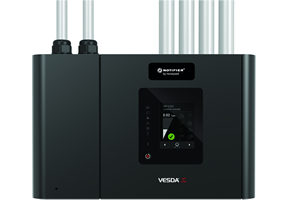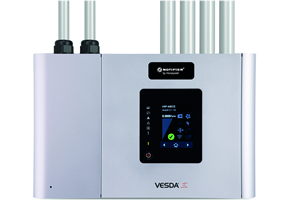Intelligent VESDA-E VES Notifier 2nd Gen. FlashScan SLC with VESDAnet - UL 268 7th Ed. compliant
The Notifier Intelligent VESDA-E VES SLC with VESDAnet detectors (referred to as 2nd Gen. detectors) have an integrated Signaling Line Circuit (SLC) module to communicate with Notifier Fire Alarm Control Panels (FACP) directly over the SLC loop. The 2nd Gen. detectors are variants of the conventional VESDA-E VES detectors with built-in SLC interface module.

The SLC connectivity and SLC address occupancy on the 2nd Gen. detectors is backward compatible with the 1st Gen. detectors.The 2nd Gen. detectors have new features which are mainly VESDAnet communication and UL 268 7th Edition compliance, hence the addition of the “-VN” suffix to the model number, where the “VN” stands for VESDAnet communication. The UL 268 7th Edition introduces a new level of performance for smoke detectors aiming to improve the life safety of the building occupants and reduce nuisance alarms.
Similar to the regular VES mechanism of operation, the intelligent 1st and 2nd Gen. VES SLC detector draws air from all sectors in use. If the smoke level reaches the Adaptive Scan Threshold, the intelligent VES quickly scans each sector to identify which sector is carrying smoke. The first sector to reach the alert level is designated as the First Alarm Sector (FAS) and this sector is signaled to the user on the detector display. If two or more sectors reach the alert level, the sector with the highest smoke concentration is designated as the First Alarm Sector (FAS). Once Fast Scan is completed and the FAS identified, the intelligent VES continues to closely monitor all four sectors to track fire growth and maintain full protection of the area.
On the fire alarm panel side, if two or more sectors are at different alarm levels, then general alarms corresponding to each threshold
(Alert, Action, Fire 1, or Fire 2) will be raised by the panel but the sector carrying the highest smoke concentration will be shown on the panel display. Similarly, if two or more sectors are having the same alarm level, then the sector which was reported first by the detector will be shown on the panel display.
Features:
- Sector addressability for up to four sectors
- Adaptive scan threshold
- Flair detection technology delivers reliables very early warning in a wide range of environments with minimal nuisance alarms
- Multi-stage filtration and optical protection with clean air barriers ensures lifetime detection performance
- Four configurable alarm levels for sector 1 (sectors 2, 3 and 4 will automatically assume the same values that are set in sector 1) and a wide sensitivity range deliver optimum protection for the widest range of applications
- Intuitive LCD display provides instant status information for immediate response
- Flow fault thresholds per port accommodate varying airflow conditions
- Smart on-board filter retains dust count and remaining filter life for predictable maintenance
- Extensive event log (20,000 events) for event analysis and system diagnostics
- AutoLearn™ smoke for reliable and rapid commissioning
- Backward compatible with VLS
- Ethernet for connectivity with Xtralis software for configuration, secondary monitoring, and maintenance
- USB for PC configuration and firmware upgrade using a memory stick
- Field replaceable sub-assemblies enable faster service and maximum uptime
- Providing both SLC and VESDAnet connectivity
- Supporting three modes of operation (SLC mode, VESDA-E Conventional Mode and VESDA-E Mimic Mode)
- The different modes of operation allow for supporting Notifier HLI (VHX-1420-HFS) connectivity under non-SLC modes
Specifications
Operating Conditions1
- Ambient: 32°F to 100°F (0°C to 38°C)
- Sampled Air: -4°F to 140°F (-20°C to 60°C)2
- Humidity: 5% to 95% RH, non-condensing ambient: 32°F to 100°F (0°C to 38°C)
Storage Conditions (Non-operational)
- Humidity: Dry (<>
- Temperature: 0° to 85°C
Must not be exposed to sunlight or other radiation sources
- 12 programmable relays, contacts rated 2 A @ 30 VDC (Resistive)
- Unmonitored GPI: In the SLC mode of operation, the Unmonitored GPI is pre-configured to the Remote Reset function
- Monitored GPI: In the SLC mode of operation, the Monitored GPI is pre-configured for the Mains OK Signal
- In the other modes of operation, the GPIs are programmable
- Connection to the Fire Alarm Control Panel Direct connection to the SLC loop through recommended wiring
- Cable termination Screw terminal blocks (0.2-2.5 sq mm, 24-14 AWG)
- SLC connection from IFC card terminal block (0.2-2.5 sq mm, 24-14 AWG)
- Measurement Range 0.0000% to 11.09% obs/ft (0.000 to 32% obs/m)
- Sensitivity Range 0.0015 to 6.575% obs/ft (0.005 to 20% obs/m)
1 Please consult your Notifier representative for information on operation outside these parameters or where sampled air is continually above 0.015% obs/ft (0.05% obs/m) under normal operating conditions.
2 Sampled air temperature shall reach detector ambient temperature upon entry into detector. Refer to Xtralis Design Guides and Application Notes for sampled air preconditioning.
Listings:
- UL/ULC
- CSFM listed
Resources
Basket Size :
0 MB out of 50 MB
| Document Name | Asset Type | Type & Size | Modified Date | |
|---|---|---|---|---|
| VESDA-E VES SLC with VESDAnet Detectors | Data Sheets | pdf | 0.70 MB | 04/01/2024 | |
| VESDA-E SLC 2nd Gen. Sell Sheet | Sell Sheet | pdf | 0.60 MB | 04/01/2024 |



